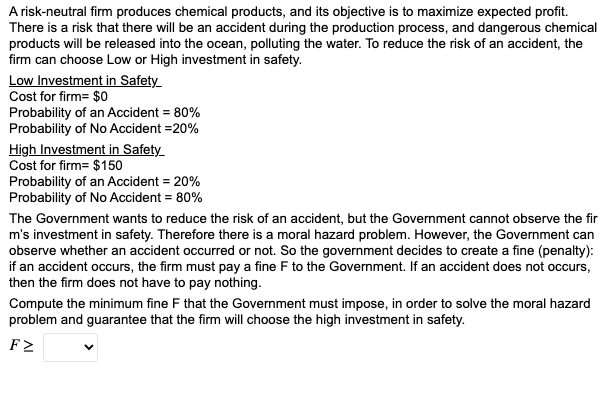A risk-neutral firm produces chemical products, and its objective is to maximize expected profit. There is a risk that there will be an accident during the production process, and dangerous chemical products will be released into the ocean, polluting the water. To reduce the risk of an accident, the firm can choose Low or High investment in safety. Low Investment in Safety. Cost for firm= $0 Probability of an Accident = 80% Probability of No Accident =20% High Investment in Safety Cost for firm= $150 Probability of an Accident = 20% Probability of No Accident = 80% The Government wants to reduce the risk of an accident, but the Government cannot observe the fir m's investment in safety. Therefore there is a moral hazard problem. However, the Government can observe whether an accident occurred or not. So the government decides to create a fine (penalty): if an accident occurs, the firm must pay a fine F to the Government. If an accident does not occurs, then the firm does not have to pay nothing. Compute the minimum fine F that the Government must impose, in order to solve the moral hazard problem and guarantee that the firm will choose the high investment in safety
A risk-neutral firm produces chemical products, and its objective is to maximize expected profit. There is a risk that there will be an accident during the production process, and dangerous chemical products will be released into the ocean, polluting the water. To reduce the risk of an accident, the firm can choose Low or High investment in safety. Low Investment in Safety. Cost for firm= $0 Probability of an Accident = 80% Probability of No Accident =20% High Investment in Safety Cost for firm= $150 Probability of an Accident = 20% Probability of No Accident = 80% The Government wants to reduce the risk of an accident, but the Government cannot observe the fir m's investment in safety. Therefore there is a moral hazard problem. However, the Government can observe whether an accident occurred or not. So the government decides to create a fine (penalty): if an accident occurs, the firm must pay a fine F to the Government. If an accident does not occurs, then the firm does not have to pay nothing. Compute the minimum fine F that the Government must impose, in order to solve the moral hazard problem and guarantee that the firm will choose the high investment in safety
Chapter18: Asymmetric Information
Section: Chapter Questions
Problem 18.5P
Related questions
Question

Transcribed Image Text:A risk-neutral firm produces chemical products, and its objective is to maximize expected profit.
There is a risk that there will be an accident during the production process, and dangerous chemical
products will be released into the ocean, polluting the water. To reduce the risk of an accident, the
firm can choose Low or High investment in safety.
Low Investment in Safety_
Cost for firm= $0
Probability of an Accident = 80%
Probability of No Accident =20%
High Investment in Safety
Cost for firm= $150
Probability of an Accident = 20%
Probability of No Accident = 80%
The Government wants to reduce the risk of an accident, but the Government cannot observe the fir
m's investment in safety. Therefore there is a moral hazard problem. However, the Government can
observe whether an accident occurred or not. So the government decides to create a fine (penalty):
if an accident occurs, the firm must pay a fine F to the Government. If an accident does not occurs,
then the firm does not have to pay nothing.
Compute the minimum fine F that the Government must impose, in order to solve the moral hazard
problem and guarantee that the firm will choose the high investment in safety.
FZ
Expert Solution
This question has been solved!
Explore an expertly crafted, step-by-step solution for a thorough understanding of key concepts.
This is a popular solution!
Trending now
This is a popular solution!
Step by step
Solved in 2 steps

Knowledge Booster
Learn more about
Need a deep-dive on the concept behind this application? Look no further. Learn more about this topic, economics and related others by exploring similar questions and additional content below.Recommended textbooks for you


Managerial Economics: A Problem Solving Approach
Economics
ISBN:
9781337106665
Author:
Luke M. Froeb, Brian T. McCann, Michael R. Ward, Mike Shor
Publisher:
Cengage Learning


Managerial Economics: A Problem Solving Approach
Economics
ISBN:
9781337106665
Author:
Luke M. Froeb, Brian T. McCann, Michael R. Ward, Mike Shor
Publisher:
Cengage Learning